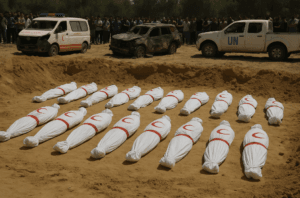Outrage: 15 Aid Workers Killed in Gaza – Australia Demands 1 Urgent, Powerful Investigation
Australia has joined growing international calls for an independent investigation after 15 Palestinian medics and emergency workers were killed by Israeli forces in southern Gaza. The victims, including Red Crescent staff, civil defence workers, and a UN official, were found in a shallow mass grave near Rafah beside destroyed emergency vehicles. Footage and eyewitness accounts dispute Israel’s claim that the convoy was acting suspiciously, showing the vehicles had emergency lights on before being fired upon.
Australia’s Foreign Minister Penny Wong called the deaths unacceptable and demanded accountability through a thorough, impartial probe. The Israeli military has launched its own internal investigation but has been criticized for lack of transparency and oversight. UN officials have raised concerns that the killings may amount to war crimes under international law. Australia is also pushing for global measures to better protect humanitarian workers. Meanwhile, tensions in Gaza continue to rise as ceasefire efforts falter and Israeli strikes resume.

Outrage: 15 Aid Workers Killed in Gaza – Australia Demands 1 Urgent, Powerful Investigation
Australia has urged an independent probe into the deaths of 15 Palestinian medics and emergency workers killed by Israeli forces in southern Gaza, joining global demands for accountability. The victims—eight from the Palestinian Red Crescent, six from Gaza’s civil defense agency, and one UN staff member—were discovered in a shallow mass grave near Rafah. Their bodies were found alongside destroyed ambulances and rescue vehicles clearly marked with aid organization logos, raising alarms over possible violations of international humanitarian law.
The incident came to light after the United Nations released video evidence showing the recovery of the bodies, directly contradicting Israel’s initial claims. Israeli authorities had alleged the medical convoy was acting suspiciously, lacked proper sirens or lights, and posed a security threat. However, footage shared with the UN Security Council and published by The New York Times revealed the vehicles’ emergency lights were active moments before being struck by Israeli gunfire. This evidence has intensified scrutiny of Israel’s military conduct in Gaza.
Australian Foreign Minister Penny Wong strongly condemned the killings, calling them “unacceptable” and demanding accountability. Her office stressed the need for an impartial investigation to determine whether international laws protecting humanitarian workers were breached. “Those responsible must answer for their actions,” a statement read, echoing calls from other nations for transparency. Wong also emphasized the importance of upholding ceasefire agreements and restarting negotiations to secure the release of Israeli hostages held by Hamas.
The Israeli Defense Forces (IDF) confirmed targeting the convoy but denied intentionally attacking aid workers. Instead, they claimed the strike was aimed at Hamas operatives in the area. The military stated that nine individuals were killed, though only one—an alleged Hamas member—has been publicly identified. This account clashes with witness testimonies and a forensic examination by a Gaza-based expert, who told The Guardian that several bodies bore multiple gunshot wounds, suggesting close-range fire.
Critics have questioned the IDF’s decision to conduct an internal investigation without independent oversight, citing a history of military probes that absolve Israeli forces of wrongdoing. While the IDF says it is reviewing all evidence, including the UN footage, human rights groups argue external scrutiny is essential to ensure credibility. The delay in granting UN and Red Crescent teams access to the site—described by Israel as an active combat zone—has further fueled accusations of a cover-up.
UN Human Rights Chief Volker Türk warned the incident may amount to a war crime, stressing that attacks on clearly marked medical personnel and vehicles are prohibited under international law. The strike adds to growing concerns over Israel’s compliance with legal standards during its Gaza offensive, which has drawn widespread condemnation for its high civilian death toll.
In response, Australia is leading efforts to bolster protections for aid workers in conflict zones. Senator Wong’s office announced plans to rally international support for a new declaration aimed at safeguarding humanitarian personnel, particularly in Gaza, where over 200 aid workers have been killed since the war began. The move aligns with Australia’s broader calls for an immediate ceasefire, the release of hostages, and increased humanitarian aid to Gaza’s devastated population.
The incident occurred amid a collapse in temporary truce talks between Israel and Hamas. Israel resumed military operations in Gaza on March 18 after negotiations stalled, with Hamas still believed to hold 59 Israeli hostages. At least 35 of these captives are feared dead, according to Israeli officials. The renewed fighting has worsened conditions in Gaza, where hospitals, schools, and refugee camps have repeatedly been struck, displacing over a million people.
As global outcry grows, the focus remains on securing justice for the slain medics and ensuring such tragedies are prevented in the future. With Australia and other nations pressing for accountability, the incident underscores the urgent need for independent investigations into military actions in Gaza—and for all parties to prioritize the protection of civilians and aid workers caught in the crossfire.
You must be logged in to post a comment.